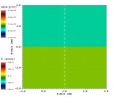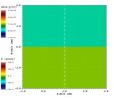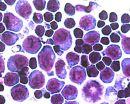(Press-News.org) VIDEO:
This video simulation shows how a laser that illuminates a small carbon rod launches a complex flow, consisting of supersonic shocks and turbulent flow. When the grid is present, turbulence...
Click here for more information.
Astrophysicists have established that cosmic turbulence could have amplified magnetic fields to the strengths observed in interstellar space.
"Magnetic fields are ubiquitous in the universe," said Don Lamb, the Robert A. Millikan Distinguished Service Professor in Astronomy & Astrophysics at the University of Chicago. "We're pretty sure that the fields didn't exist at the beginning, at the Big Bang. So there's this fundamental question: how did magnetic fields arise?"
Helping to answer that question, which is of fundamental importance to understanding the universe, were millions of hours of supercomputer simulations at Argonne National Laboratory. Lamb and his collaborators, led by scientists at the University of Oxford, report their findings in an article published in the June 1 issue of Nature Physics.
The paper describes experiments at the Vulcan laser facility of the United Kingdom's Rutherford Appleton Laboratory that recreates a supernova (exploding star) with beams 60,000 billion times more powerful than a laser pointer. The research was inspired by the detection of magnetic fields in Cassiopeia A, a supernova remnant, which are approximately 100 times stronger than those in adjacent
interstellar space.
Physics at multiple scales
"It may sound surprising that a tabletop laboratory experiment that fits inside an average room can be used to study astrophysical objects that are light years across," said Gianluca Gregori, professor of physics at Oxford. "In reality, the laws of physics are the same everywhere, and physical processes can be scaled from one to the other in the same way that waves in a bucket are comparable to waves in the ocean. So our experiments can complement observations of events such as the Cassiopeia A supernova."
Making the advance possible was the extraordinarily close cooperation between Lamb's team at UChicago's Flash Center for Computational Science and Gregori's team of experimentalists.
"Because of the complexity of what's going on here, the simulations were absolutely vital to inferring exactly what's going on and therefore confirming that these mechanisms are happening and that they are behaving in the way that theory predicts," said Jena Meinecke, graduate student in physics at Oxford and lead author of the Nature Physics paper.
Magnetic fields range from quadrillionths of a gauss in the cosmic voids of the universe, to several microgauss in galaxies and galaxy clusters (ordinary refrigerator magnets have magnetic fields of approximately 50 gauss). Stars like the sun measure thousands of gauss. Neutron stars, which are the extremely compact, burned out cores of dead stars, exhibit the largest magnetic fields of all, ones exceeding quadrillions of gauss.
In 2012, Gregori's team successfully created small magnetic fields, called "seed fields," in the laboratory via an often-invoked effect called the Biermann battery mechanism. But how could seed fields grow to gigantic sizes in interstellar space? Building on their earlier findings, Gregori and his collaborators at 11 institutions worldwide now have demonstrated the amplification of magnetic fields by turbulence.
In their experiment, the scientists focused laser beams onto a small carbon rod sitting in a chamber filled with a low-density gas. The lasers, generating temperatures of a few million degrees, caused the rod to explode, creating a blast that expanded throughout the gas.
"The experiment demonstrated that as the blast of the explosion passes through the grid it becomes irregular and turbulent, just like the images from Cassiopeia," Gregori said.
Experimental variables
"The experimentalists knew all the physical variables at a given point. They knew exactly the temperature, the density, the velocities," said UChicago research scientist Petros Tzeferacos, a study co-author. Tzeferacos and his colleagues incorporated that data into their FLASH simulations.
"This allows us to benchmark the code against something that we can see," Tzeferacos said. Such benchmarking—called validation—shows that the simulations can reproduce the experimental data. The simulations consumed 20 million processing hours on both the Mira and Intrepid supercomputers at Argonne. Mira, which can perform 10 quadrillion calculations per second, is 20 times faster than Intrepid.
With validation in hand, all members of the collaboration could return repeatedly to the simulations to get answers to new questions regarding the physics they saw. "We could look at the velocity instead of the density of the magnetic field, or we might look at the pressure," Lamb said. "This simulation is a treasure trove of information about what's really going on. It's actually critical to understanding correctly what's really happening."
INFORMATION:
The magnetic field simulations were made possible by the addition of capabilities to the FLASH Code in recent years, funded by the Office of Advanced Simulation and Computing in the Department of Energy's National Nuclear Security Agency. Originally designed to support computer simulations of exploding stars, FLASH Code also now supports high-energy density physics simulations to better understand the properties of matter at high densities and high temperatures.
Citation:
"Turbulent amplification of magnetic fields in laboratory laser-produced shock waves," by J. Meinecke and 26 others, Nature Physics, June 1, 2014.
Funding:
U.S. Department of Energy through the Innovative and Novel Computational Impact on Theory and Experiment (INCITE) program.
International collaboration replicates amplification of cosmic magnetic fields
2014-06-01
ELSE PRESS RELEASES FROM THIS DATE:
Researchers discover hormone that controls supply of iron in red blood cell production
2014-06-01
A UCLA research team has discovered a new hormone called erythroferrone, which regulates the iron supply needed for red blood-cell production.
Iron is an essential functional component of hemoglobin, the molecule that transports oxygen throughout the body. Using a mouse model, researchers found that erythroferrone is made by red blood-cell progenitors in the bone marrow in order to match iron supply with the demands of red blood-cell production. Erythroferrone is greatly increased when red blood-cell production is stimulated, such as after bleeding or in response to anemia.
The ...
Leptin also influences brain cells that control appetite, Yale researchers find
2014-06-01
Twenty years after the hormone leptin was found to regulate metabolism, appetite, and weight through brain cells called neurons, Yale School of Medicine researchers have found that the hormone also acts on other types of cells to control appetite.
Published in the June 1 issue of Nature Neuroscience, the findings could lead to development of treatments for metabolic disorders such as obesity and diabetes.
"Up until now, the scientific community thought that leptin acts exclusively in neurons to modulate behavior and body weight," said senior author Tamas Horvath, the ...
Mayo Clinic: Ovarian cancer subtypes may predict response to bevacizumab
2014-06-01
CHICAGO — Molecular sequencing could identify ovarian cancer patients who are most likely to benefit from treatment with bevacizumab (Avastin), a Mayo Clinic-led study has found. Results of the research were presented today at the 2014 American Society of Clinical Oncology Annual Meeting.
The addition of bevacizumab to standard therapy extended progression-free survival more for ovarian cancer patients with molecular subtypes labeled as "proliferative" or "mesenchymal" compared to those with subtypes labeled as "immunoreactive" or "differentiated," says Sean Dowdy, M.D., ...
Oncologists: How to talk with your pathologist about cancer molecular testing
2014-06-01
As targeted therapies become more available, increasing opportunity exists to match treatments to the genetics of a specific cancer. But in order to make this match, oncologists have to know these genetics. This requires molecular testing of patient samples. An education session presented today at the American Society for Clinical Oncology (ASCO) Annual Meeting 2014 details the challenges in this process and makes recommendations that oncologists can use to ensure their patients' samples are properly tested, helping to pair patients with the best possible treatments.
"The ...
Chemotherapy following radiation treatment improves progression-free survival
2014-06-01
CHICAGO — A chemotherapy regimen consisting of procarbazine, CCNU, and vincristine (PCV) administered following radiation therapy improved progression-free survival and overall survival in adults with low-grade gliomas, a form of brain cancer, when compared to radiation therapy alone. The findings were part of the results of a Phase III clinical trial presented today at the 2014 American Society of Clinical Oncology Annual Meeting by the study's primary author Jan Buckner, M.D., deputy director, Cancer Practice, at Mayo Clinic Cancer Center.
"On average, patients who ...
New report estimates nearly 19 million cancer survivors in the US by 2024
2014-06-01
ATLANTA – June 1, 2014 – The number of cancer survivors in the United States, currently estimated to be 14.5 million, will grow to almost 19 million by 2024, according to an updated report by the American Cancer Society. The second edition of Cancer Treatment & Survivorship Facts & Figures, 2014-2015 and an accompanying journal article published in CA: A Cancer Journal for Clinicians find that even though cancer incidence rates have been decreasing for ten years, the number of cancer survivors is growing. This is the result of increases in cancer diagnoses driven by the ...
Reducing emissions will be the primary way to fight climate change, UCLA-led study finds
2014-06-01
Forget about positioning giant mirrors in space to reduce the amount of sunlight being trapped in the earth's atmosphere or seeding clouds to reduce the amount of light entering earth's atmosphere. Those approaches to climate engineering aren't likely to be effective or practical in slowing global warming.
A new report by professors from UCLA and five other universities concludes that there's no way around it: We have to cut down the amount of carbon being released into the atmosphere. The interdisciplinary team looked at a range of possible approaches to dissipating ...
ALTTO test of dual HER2 blockade finds single agent remains the gold standard
2014-06-01
CHICAGO — June 1, 2014 — In the largest clinical trial testing the effectiveness of one versus two drugs to treat HER2-positive breast cancer, lapatinib (Tykerb) did not add benefit to the standard trastuzumab (Herceptin) adjuvant therapy, researchers report at the 50th annual meeting of the American Society of Clinical Oncology (ASCO).
MULTIMEDIA ALERT: Video and audio are available for download on the Mayo Clinic News Network.
Results of the phase III clinical trial, ALTTO (Adjuvant Lapatinib and/or Trastuzumab Treatment Optimization study), demonstrated that adding ...
The ethics of knowing where to stop treatment in a sick and elderly patient
2014-06-01
An Emeritus Professor of medical ethics at Imperial College London will deliver a presentation at this year's Euroanaesthesia meeting titled 'Escalating care for the comorbid elderly-where do we stop?". Raanan Gillon, who is President of the UK's Institute of Medical Ethics, will argue that a patient's age should not in itself be considered an ethically relevant criterion for deciding 'where to stop'.
Acknowledging that there is a morally plausible counter-argument – known in the UK as 'the fair innings argument'- according to which scarce life prolonging resources should ...
Study of 55 million people adds further evidence that patients admitted to hospital at weekends have higher mortality
2014-06-01
A systematic review and meta-analysis of hospital data worldwide, presented as this year's Euroanaesthesia meeting in Stockholm, adds further evidence that patients admitted to hospital at weekends have higher mortality than those admitted on weekdays. The study is by Dr Hiroshi Hoshijima, Tohoku University, Sendai, Japan, and colleagues.
The analysis included 72 studies from various world regions, covering 55,053,719 participants. The authors found that weekend admission was associated with increased morality of between 15% and 17% depending on the statistical technique ...


